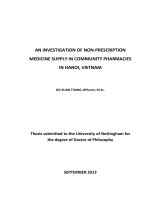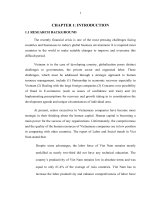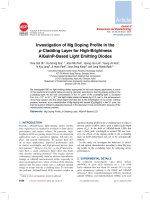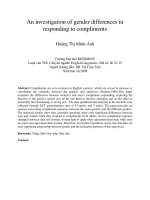An investigation of non-prescription medicine supply in community pharmacies in Hanoi, Vietnam
Bạn đang xem bản rút gọn của tài liệu. Xem và tải ngay bản đầy đủ của tài liệu tại đây (4.57 MB, 390 trang )
AN INVESTIGATION OF NON-PRESCRIPTION
MEDICINE SUPPLY IN COMMUNITY PHARMACIES
IN HANOI, VIETNAM
DO XUAN THANG, BPharm, M.Sc.
Thesis submitted to the University of Nottingham for
the degree of Doctor of Philosophy
SEPTEMBER 2013
ii
Abstract
Supplying safe, appropriate and effective non-prescription medicines for customers in
community pharmacies is a key role of pharmacists and pharmacy assistants in every country.
However, in low and middle-income countries, including Vietnam, the quality of professional
services from pharmacies is limited, unclear and has often been questioned. There is limited
research about the real situation surrounding non-prescription medicine supply in community
pharmacies in Vietnam. The factors that influence the supply of non-prescription medicines to
customers and to what extent the service provision could be improved for the benefit of
pharmacy customers needs to be explored. This study aimed to investigate non-prescription
medicines supply in community pharmacies in Hanoi, Vietnam in order to provide scientific
evidence about the situation.
A mixed method approach was used in this study to provide valuable insights into what occurs
during pharmacy staff-customer transactions. Following ethical approval, fieldwork observations
were undertaken in five community pharmacies over a five week period from March to May
2011, this was followed by 22 semi-structured interviews with eight pharmacists and 14
pharmacy assistants who had been observed. The interviews enabled participants to express
their perceptions and experiences regarding the supply of non-prescription medicines to
customers in community pharmacies. Survey research, using a structured questionnaire, was
conducted with 505 pharmacy customers who were asked to evaluate the pharmacy service that
they had just received. Results from the three sources were triangulated and validated by
comparing, contrasting, complementing and confirming in order to provide a better
understanding of non-prescription medicines supply and make recommendations for improving
the service provision in community pharmacies in Vietnam.
The findings from this study indicate that factors influencing the supply of non-prescription
medicines in community pharmacies include attitudes of pharmacy staff, their medical and
pharmaceutical knowledge and their communication skills. The influence of the pharmacy
iii
settings, customer factors such as customers’ complex and diverse demands, the irrational use
of medicines, using medicines following the suggestions of others, and tough customers were all
factors that impacted on staff-customer transactions. Being conveniently located, the pharmacy
offering reasonably priced medicines and being a large pharmacy with a good reputation were
also considered important impacting on customer selection of community pharmacy.
The results of this research show that there are limitations in pharmacy service provision and
there is a discrepancy between pharmacy staff perceptions and actual practice in terms of
attitudes. Poor performance, in many situations, did not come from a lack of knowledge; rather
it appeared to result from the negative attitudes of pharmacy staff. Such negative attitudes of
pharmacy staff are likely to be related to their focus on just short-term profit rather than
focusing on a balance between short-term and long-term benefits for both customers and
pharmacies. Positive attitudes, taking greater responsibility, customer loyalty and long-term
benefits were ignored. Poor performance of pharmacy staff, to some extent, was also affected
by their education and training. Some educational organisations have commercialised their
training activities and paid too much attention to the quantity of graduated students rather than
the quality of their education and training.
This study has important implications for the improvement of the responsible supply of non-
prescription medicines in community pharmacies in Vietnam including the identified needs for
attitude interventions and training. New subjects should be added to the pharmacy students’
curricula and training should be developed for pharmacy assistants in areas such as
communication skills, customer psychology, selling skills and patient safety. For pharmacists and
pharmacy assistants, gaining treatment experience from customers’ feedback and keeping up to
date with new information should be a continuous activity. Close co-operation between health
authorities, policy makers and researchers needs to be developed in conducting further research
and implementing appropriate policies, in order to improve the service provision in community
pharmacies in Vietnam.
iv
ACKNOWLEDGEMENTS
There are a number of people who I would like to thank, and without whom this project would
not have been possible.
Firstly, I would like to thank my supervisors, Professor Claire Anderson and Dr Helen Boardman.
They have given generously their time and support throughout the course of this PhD and their
ideas, knowledge and insights, their thoughtful advice and comments have been invaluable.
Secondly, I would like to thank Vietnamese Government, Ministry of Education and Training for
funding this study. Without their support I would not have been able to complete this study.
Thirdly, thanks are given to the University of Nottingham, Graduate School for providing many
valuable training courses. I have gained enormously research experiences that training courses
have provided throughout my PhD. Thanks are also given to my PhD friends and colleagues in
Division of Social Research in Medicines and Health, School of Pharmacy, the University of
Nottingham, for their friendship, their valuable advice and support for my project.
I would also like to thank all of the participants of this study who generously gave their time and
their thoughts to make this study possible.
Most of all, I would like to thank my family, my parents, my wife Lam Hong Nguyen, my sons
Tung Do Xuan and Trung Do Xuan for their lifetime of love, tremendous support and
encouragement. I could not have done this without them. They are all my life.
v
PUBLICATIONS
T.X. Do, H.F. Boardman and C.W. Anderson (2013) Community pharmacists’ perspectives on
improving responsible supply of non-prescription medicines in Vietnam. International
Journal of Pharmacy Practice, 21 (Suppl 1), 38
FIP Centennial Congress of Pharmacy and Pharmaceutical Sciences, October 2012
(Amsterdam, the Netherlands)
Thang, D.X., Boardman, H., Anderson, C., Pharmacy customers’ opinions about the
counselling for non-prescription medicines in community pharmacies in Vietnam. 2012 FIP
Centennial Congress, Available from:
Thang, D.X., Boardman, H., Anderson, C., Pharmacy staff perspectives on the influence of
advertising and the media on customers’ selection of non-prescription medicines in
Vietnam. 2012 FIP Centennial Congress, Available from:
vi
TABLE OF CONTENTS
ABSTRACT…………………………………………………………………………………………………………………… ii
ACKNOWLEDGEMENTS ……………… ……………………………………………………………………………….iv
PUBLICATIONS……………………………………………………………………………………………………………….v
TABLE OF CONTENTS……………………….………………………………………………………………………… vi
LIST OF TABLES……………………………….…………………………………………………………………………….xiii
LIST OF BOXES………………………………………………………………………………………………………………xiv
LIST OF FIGURES……………………………….………………………………………………………………………… xv
LIST OF TERMS AND ABBREVIATIONS………………………………………………………………………… xvii
CHAPTER ONE: INTRODUCTION 1
1.1 Introducing the study 1
1.2 Structure of the thesis 3
CHAPTER TWO: LITERATURE REVIEW 5
2.1 Introduction 5
2.2 The health care system in Vietnam 6
2.2.1 Structure of health care system in Vietnam 6
2.2.2 Health care expenditure 10
2.2.3 Health care financing and insurance system 13
2.3 Community pharmacy in Vietnam 17
2.3.1 Historical development 17
2.3.2 The role of community pharmacies in Vietnam 18
2.4 The overview of non-prescription medicines 19
2.4.1 Definitions of non-prescription medicines 19
2.4.2 Criteria to classify drugs as non-prescription medicines 20
2.4.3 Standards for the supply of non-prescription medicines 21
2.5 Quality and quality of care 23
2.5.1 Basis concepts in quality and quality of care 23
2.5.2 Dimensions of quality of care 24
2.5.3 Assessing quality of care 27
2.6 Supply of non-prescription medicines around the world 30
vii
2.6.1 Counselling for non-prescription medicines 31
2.6.2 Appropriate supply of non-prescription medicines 34
2.6.3 The supply of medicines in low and middle-income countries 37
2.7 Improving the supply of non-prescription medicines 39
2.8 The supply of medicines in community pharmacies in Vietnam 43
2.9 Summary 46
2.10 Aims and objectives 47
CHAPTER THREE: METHODOLOGY AND METHODS 48
3.1 Introduction 48
3.2 Choice of methodology 48
3.2.1 Mixed methods approaches 49
3.2.2 Qualitative methods 56
3.2.2.1 Observational methods 60
3.2.2.2 Interview methods 64
3.2.2.3 Qualitative data analysis 67
3.2.3 Quantitative methods – questionnaires 69
3.2.4 Validity and reliability 71
3.2.4.1 Validity and reliability: qualitative perspectives 72
3.2.4.2 Validity and reliability: quantitative perspectives 74
3.2.5 Data translation methods 75
3.2.5.1 Types of translation 75
3.2.5.2 Ensuring the quality of translation 78
3.3 Ethical considerations 80
3.4 Developing research tools 82
3.4.1 Observation instrument 84
3.4.2 Interview schedule 85
3.4.3 Survey – structured questionnaire 86
3.5 The pilot study 87
3.6 Recruitment 89
3.6.1 Selection of pharmacies to be observed 89
3.6.2 Recruitment of participants for the interviews 90
3.6.3 Recruitment of participants for the survey 90
3.7 Data collection 91
3.7.1 Observations in community pharmacies 91
viii
3.7.2 Pharmacist and pharmacy assistant interviews 94
3.7.3 Survey with pharmacy customers 94
3.8 Data translation 95
3.9 Data management and analysis 96
3.9.1 Qualitative data analysis process 98
3.9.2 Data management 99
3.9.3 Quantitative Data analysis 100
3.10 Validity and reliability of the study 101
3.10.1 Validity and reliability of the qualitative studies 101
3.10.2 Validity and reliability of the quantitative study 101
3.11 Summary 102
CHAPTER FOUR: PHARMACY OBSERVATIONS 103
4.1 Introduction 103
4.2 Influence of pharmacy setting on customer-staff interactions 109
4.3 Customer factors impacting on the supply of NPMs 116
4.3.1 Customer requests for general medical and pharmaceutical advice 116
4.3.2 Customer requests for a particular type of non-prescription medicines 120
4.3.3 Influence of others on customer demands 125
4.3.4 Other situations that influence transactions 126
4.4 Pharmacy staff attitudes and NPM transactions 128
4.4.1 Responsible medicine supply 128
4.4.2 Irresponsible medicine supply 130
4.4.3 GP referrals 132
4.5 Pharmacy staff knowledge and non-prescription medicine supply 134
4.5.1 Pharmacy staff demonstrating good knowledge 134
4.5.2 Pharmacy staff demonstrating a lack of knowledge 137
4.6 Communication skills and supply of non-prescription medicines 138
4.7 Summary 143
CHAPTER FIVE: PHARMACY STAFF PERSPECTIVES 144
5.1 Introduction 144
5.2 The roles of community pharmacies 147
5.2.1 Community pharmacies as a first choice for health care 148
5.2.2 Pharmacy is different from other retailers 151
5.2.3 Pharmacy staff as psychologists 152
ix
5.2.4 Selling non-prescription medicines in community pharmacies 153
5.2.5 More power when selling non-prescription medicines 158
5.2.6 Lack of pharmacists working in community pharmacies 159
5.2.7 Reputation of pharmacy and loyalty 161
5.3 Attitude and ethical issues 164
5.3.1 Attitudes and ethical considerations 165
5.3.1.1 Importance of attitudes and ethical issues 165
5.3.1.2 Problems of attitudes and ethical issues 167
5.3.2 Care about customers’ health concerns 168
5.3.3 Responsibilities 170
5.3.3.1 Responsibility for patient safety 172
5.3.3.2 Responsible for rational use of medicines 175
5.3.3.3 Responsibility for customers’ economic status and affordability 179
5.3.3.4 Time spent on staff-customer transactions 182
5.3.4 Selling medicines without giving any questions and advice 184
5.3.5 Selling medicines for profit 185
5.3.6 Attitudes of pharmacy staff 189
5.3.7 Summary 196
5.4 Communication skills 199
5.4.1 Importance of communication skills 200
5.4.2 Questioning skills 202
5.4.2.1 Commonly employed questions 204
5.4.2.2 Asking about a customer’s medical history 208
5.4.2.3 Asking about allergy to medicines 209
5.4.3 Listening skills 213
5.4.4 Giving advice 216
5.4.4.1 Verbal and written instructions 217
5.4.4.2 Lifestyle advice 219
5.4.4.3 Consistency when giving advice 220
5.4.5 Relationship with customers 221
5.4.6 Limitations in communication skills of pharmacy staff 222
5.5 Knowledge of pharmacy staff 224
5.5.1 Medical and pharmaceutical knowledge requirements 225
5.5.2 Quality of education and training 227
x
5.5.3 Ability to self educate and update information 231
5.5.4 Learning from customers’ feedback 234
5.6 Customer factors 235
5.6.1 Customers’ requests for medicines 236
5.6.2 Influence of media and advertisements on customers’ selections 237
5.6.3 The price of medicine 239
5.6.4 Irrational use or overuse of medicines 240
5.6.5 Using medicines following the suggestions of others 241
5.6.6 Customers’ beliefs and adherence to medication 242
5.6.7 Customers prefer handwritten instructions 244
5.6.8 Feedback from customers 245
5.6.9 Customers’ trust in the pharmacy and customer loyalty 246
5.7 Summary 247
CHAPTER SIX: SURVEY OF PHARMACY CUSTOMERS 256
6.1 Introduction 256
6.2 Descriptive results 256
6.2.1 Characteristics of respondents 257
6.2.2 The non-prescription medicines transaction 259
6.2.3 Associations between customer reports and demographics 261
6.2.3.1 Respondents report of pharmacy staff performance by gender 261
6.2.3.2 Respondents report of pharmacy staff performance by age group 263
6.2.3.3 Respondents report of pharmacy staff performance by educational level
265
6.3 Respondents’ evaluation of pharmacy staff performance 267
6.4 Respondent opinions about selecting a community pharmacy 269
6.5 Discussion 270
6.5.1 Respondents report of non-prescription medicines transaction 270
6.5.1.1 Staff questioning of customers 270
6.5.1.2 Advice-giving 272
6.5.2 Associations between customer reports and demographics 274
6.5.3 Respondents’ evaluation of pharmacy staff performance 275
6.5.3.1 Pharmacy staff attitude 275
6.5.3.2 Respondents’ evaluation of pharmacy staff knowledge 276
6.5.3.3 Pharmacy staff communication skills 277
xi
6.5.3.4 Time spending on the transaction 278
6.5.3.5 Factors influencing the supply of non-prescription medicines 278
6.5.4 Respondent opinions of selecting community pharmacy 279
6.5.5 Summary 279
CHAPTER SEVEN: DISCUSSION AND CONCLUSION 280
7.1 Introduction 280
7.2 Factors impacting on the supply of non-prescription medicines 282
7.2.1 The similarities and confirmations 282
7.2.1.1 Pharmacy staff attitudes impact on the supply of non-prescription
medicines 282
7.2.1.2 The influence of communication skills on the supply of NPMs 283
7.2.1.3 The influence of pharmacy staff knowledge on the supply of NPMs 284
7.2.2 Differences and complementary factors 285
7.2.2.1 The influence of pharmacy settings on staff-customer interactions 285
7.2.2.2 The roles of community pharmacies in Vietnam 286
7.2.2.3 Customer factors that impact on staff-customer interactions 288
7.2.3 Associations between customer reports and demographics 289
7.3 Pharmacies’ practical problems 290
7.3.1 The discrepancy between what pharmacy staff say and what they do 290
7.3.2 The awareness of short-term profit only 294
7.3.3 Poor performance as a result of education and training 295
7.3.4 The quality of pharmacy service provision regarding the supply of NPMs . 296
7.4 Improving the responsible supply of non-prescription medicines 297
7.4.1 Implications of attitude intervention 297
7.4.2 Implications for educational organisations 299
7.4.3 Implications for pharmacy staff in community pharmacies 302
7.4.4 Implications for researchers 303
7.4.5 Implications for health authorities and policy makers 304
7.5 Dissemination of the findings 304
7.6 Strengths and limitations 305
7.6.1 Strengths 305
7.6.2 Limitations 307
7.7 Future research 308
7.8 Conclusion 310
xii
REFERENCES 312
APPENDIX ONE: Health care system in Vietnam 333
APPENDIX TWO: Approval letter for the study 344
APPENDIX THREE: Participant information sheet 346
APPENDIX FOUR: Consent form 355
APPENDIX FIVE: Observation sheet 357
APPENDIX SIX: Interview schedule 359
APPENDIX SEVEN: Questionnaire 363
APENDIX EIGHT: Data checking and cleaning 369
APPENDIX NINE: Pharmacy study Poster 371
xiii
LIST OF TABLES
CHAPTER 2: LITERATURE REVIEW
Table 2- 1 Definitions of quality of care 23
Table 2- 2 Dimensions of quality of care 25
Table 2- 3 Dimensions of quality of care according to WHO 26
Table 2- 4 Dimensions in the assessment of quality of care 27
CHAPTER 3: METHODOLOGY AND METHODS
Table 3- 1 Qualitative data collection methods, options, advantages, and limitations 58
Table 3- 2 Common stages in the process of translation 79
Table 3- 3 Qualitative and quantitative data analysis procedures for mixed methods studies
97
CHAPTER 4: PHARMACY OBSERVATIONS
Table 4- 1 Description of participating pharmacies 103
Table 4- 2 Different features between CPs in Vietnam and CPs in the UK 107
Table 4- 3 Characteristics of the pharmacy sites (n=5) and number of interactions observed
108
CHAPTER 5: PHARMACISTS AND PHARMACY STAFF PERSPECTIVES
Table 5- 1 Demographic characteristics of interview participants (n=22) 145
Table 5- 2 Questions which should be asked during customer-staff transactions 211
xiv
CHAPTER 6: SURVEY OF PHARMACY CUSTOMERS
Table 6- 1 Characteristics of respondents (n=505) 257
Table 6- 2 Number of medicines bought by respondents (n=505) 258
Table 6- 3 Age groups and educational level by gender (n=505) 259
Table 6- 4 Respondents' report of pharmacy staff performance (n=505) 260
Table 6- 5 Respondents recall of pharmacy staff performance by gender (n=505) 262
Table 6- 6 Respondents recall of pharmacy staff performance by age group (n=505) 264
Table 6- 7 Respondents recall of pharmacy staff performance by educational level (n=505)
266
Table 6- 8 Respondents' evaluation on pharmacists and pharmacy staff performance
(n=505) 268
Table 6- 9 Customers' reasons for selecting the pharmacy where they purchased the
medicines (n=505) 269
LIST OF BOXES
CHAPTER 2: LITERATURE REVIEW
Box 2-1 Criteria to classify drugs as non-prescription medicines…………………………….………….20
Box 2-2 RPSGB standards for the supply of non-prescription medicines…………………………….21
xv
LIST OF FIGURES
CHAPTER 1: INTRODUCTION
Figure 1- 1 Structure of the thesis 3
CHAPTER 2: LITERATURE REVIEW
Figure 2- 1 Structure of health care system in Vietnam 7
Figure 2- 2 National health expenditure per capita in Vietnam (2008 – 2016) 10
Figure 2- 3 Vietnamese pharmaceutical market value and growth rate (2002-2013) 11
Figure 2- 4 Drug purchases per capita in Vietnam (2000-2010) 12
Figure 2- 5 Health expenditure in Vietnam (2008-16); private, public and as a % of GDP 13
Figure 2- 6 Trends in health financing in Vietnam, 1999-2008 14
CHAPTER 3: METHODOLOGY AND METHODS
Figure 3- 1 Triangulation mixed methods explanation 55
Figure 3- 2 Development of the research project 83
CHAPTER 4: PHARMACY OBSERVATIONS
Figure 4-1 Pharmacy P 1 – floor layout ……………………………………………………………………………104
Figure 4-2 Pharmacy P 2 – floor layout ……………………………………………………………………………105
Figure 4-3 Pharmacy P 3 – floor layout ……………………………………………………………………………105
Figure 4-4 Pharmacy P 4 – floor layout ……………………………………………………………………………106
Figure 4-5 Pharmacy P 5 – floor layout …………………………………………………………………………. 106
Figure 4-6 Themes from observation of customer-staff interactions about NPMs ………….108
Figure 4-7 Community pharmacy 1 (large pharmacy) customer-staff interactions,
computers, facilities and the layout of pharmacy ………………………………………………………… 109
xvi
Figure 4-8 Community pharmacy 3 (large pharmacy) …………………………………………………… 110
Figure 4-9 Community pharmacy 2 (medium pharmacy)…………………………………………………112
Figure 4-10 Community pharmacy 4 (medium pharmacy)……………………………………………….113
Figure 4-11 Community pharmacy 5 (small pharmacy) ………………………………………………… 114
CHAPTER 5: PHARMACY STAFF PERSPECTIVES
Figure 5- 1 Pharmacy staff perspectives of NPM supply 146
Figure 5- 2 Roles of community pharmacies in Vietnam 147
Figure 5- 3 Attitudes and ethical issues 164
Figure 5- 4 Participants' perceptions of taking responsibility 188
Figure 5- 5 Relationships between attitudes and communication skills 190
Figure 5- 6 Communication skills in community pharmacies 199
Figure 5- 7 Knowledge of pharmacy staff in community pharmacies 224
Figure 5- 8 Customer factors influence NPM supply 235
CHAPTER 7: DISCUSSION AND CONCLUSSIONS
Figure 7- 1 Triangulation of the research findings 281
Figure 7- 2 Discrepancy between perception and actual practice 293
xvii
List of Terms and Abbreviations
ADRs
Adverse Drug Reactions
CPs
Community Pharmacies
GDP
Gross Domestic Product
GP
General Practitioner
NHS
National Health Service in England
NICE
National Institute for Health and Care Excellence
NPMs
Non-prescription Medicines
OTC
Over The Counter
PSA
Pharmaceutical Society of Australia
QCPP
Quality Care Pharmacy Program
QCPSC
Quality Care Pharmacy Support Centre
RPSGB
Royal Pharmaceutical Society of Great Britain
UK
United Kingdom
USD
United States Dollar
WHO
World Health Organisation
This thesis employed terminologies “pharmacist”, “pharmacy assistant” and “pharmacy
staff” in the context of community pharmacy in Vietnam. Whilst the term “pharmacist” is
clearly well-known, the term “pharmacy assistant” is defined in this thesis as a person who
is working in a community pharmacy, selling non-prescription medicines, assisting
pharmacy owners and pharmacists in performing pharmacy’s tasks. The term “pharmacy
staff” includes both pharmacists and pharmacy assistants.
Chapter 1 Introduction
1
1 CHAPTER ONE: INTRODUCTION
1.1 Introducing the study
Supplying safe, appropriate and effective non-prescription medicines for customers in
community pharmacies is a key role of pharmacy staff in every country [1, 2]. However, in
low and middle-income countries, including Vietnam, the quality of professional services
from pharmacies is limited, unclear and has often been questioned [3]. Smith (2009)
suggested that further research in low and middle-income countries is required to identify
the environmental, organisational, cultural or other contextual factors that may be pre-
requisites for the success of any interventions, and how the quality of local pharmacy
services can be improved [4]. In the United Kingdom, there has been a considerable
amount of research exploring the supply of non-prescription medicines from community
pharmacies [5-7]. Improving the supply of non-prescription medicines in community
pharmacies has been considered and studied in many developed countries including United
Kingdom [8-12], Australia [13-19], Germany [20, 21] and Spain [22]. In contrast, there is
limited research about the supply of non-prescription medicines in community pharmacies
in Vietnam. So, conducting research to investigate non-prescription medicines supply in
community pharmacies in Vietnam is needed.
This chapter of my thesis provides an introduction to my research study, including the
origins and development of my PhD as well as the structure of this thesis.
Chapter 1 Introduction
2
I have been involved in the area of community pharmacy for the last ten years as part of my
role as a researcher and university lecturer in social pharmacy and pharmacy practice at
Hanoi University of Pharmacy. Over this period of time, I have observed the changes within
the pharmacy environment, and experienced some of the issues in pharmacy practice in
community pharmacies in Vietnam. I am interested in the improvement of pharmacy
practice and this raised a question in my mind as to what factors affect pharmacy service
delivery and how we can improve the quality of pharmacy services in order to provide
better care for customers. This ambition encouraged me to pursue my PhD degree in the
United Kingdom and conduct a research project in the area of pharmacy practice in
community pharmacies in Vietnam.
Chapter 1 Introduction
3
1.2 Structure of the thesis
This study is divided in to seven chapters. The current chapter (CHAPTER 1) describes the
background of the study and presents the aims and objectives. CHAPTER 2 reviews the
literature on non-prescription medicine supply, including the health care system in
Vietnam; the historical development and the role of community pharmacies in Vietnam;
non-prescription medicine supply and an overview of quality of care; the supply of non-
prescription medicines across the world; and the supply of medicines in community
pharmacies in Vietnam.
Figure 1- 1 Structure of the thesis
INTRODUCTION
METHODOLOGY
AND METHODS
RESULTS
DISCUSSION AND
CONCLUSION
Chapter 1
Introduction
to the thesis
Chapter 2
Literature
review
Chapter 3
Methodology
and methods
Chapter 4
Pharmacy
Observation
s
Chapter 5
Pharmacy staff
perspectives
Chapter 6
Survey of
pharmacy
customers
Chapter 7
Discussion
and
conclusion
Chapter 1 Introduction
4
CHAPTER 3 describes the methodology underpinning this study. The choice of mixed
methods is explained and issues of validity and reliability are discussed. The data collection
process and methods of analysis are given in detail.
CHAPTER 4 describes the observation findings including the pharmacy settings and factors
which impact on the supply of non-prescription medicines in community pharmacies.
CHAPTER 5 presents the pharmacists’ and pharmacy assistants’ perceptions of non-
prescription medicine supply in community pharmacies, the factors affecting the
transactions between pharmacy staff and customers and how the service can be improved.
CHAPTER 6 presents an analysis of pharmacy customer opinions and evaluation of
pharmacy service provision in community pharmacies regarding the supply of non-
prescription medicines. The findings are used to validate and confirm the results from
observation and interview studies.
CHAPTER 7 discusses and integrates the results from observation (chapter 4), interview
(chapter 5) and questionnaire studies (chapter 6). The findings are compared in order to
validate and expand the results for the whole research project. Finally, the implications of
the study are discussed and future research is recommended in order to improve non-
prescription medicine supply in community pharmacies in Vietnam.
Chapter 2 Literature review
5
2 CHAPTER TWO: LITERATURE REVIEW
2.1 Introduction
The purpose of this chapter is to review the literature relevant to the supply of non-
prescription medicines in community pharmacies and provide the background for
conducting a study to investigate the non-prescription medicine supply in community
pharmacies in Vietnam.
This research project was conducted in community pharmacies in Hanoi, Vietnam and in
the context of Vietnamese health care and pharmaceutical systems. A review of the
literature about the health care system in Vietnam is presented and discussed in order to
provide underpinning context for further understanding about the activities in community
pharmacies and customers’ reactions. The structure of the health care system in Vietnam is
presented; the expenditure for health care and the health care financing as well as the
insurance system are discussed. Furthermore, the historical development and the role of
community pharmacies in Vietnam are presented in order to support the research.
In addition, this research project focuses on the supply of non-prescription medicines. So
the fundamental information about non-prescription medicines such as definitions of non-
prescription or over-the-counter (OTC) medicines, criteria to classify medicines as OTC and
standards for the supply of non-prescription medicines are also presented. Finally, quality
of care is discussed in the context of health care in community pharmacies.
Chapter 2 Literature review
6
2.2 The health care system in Vietnam
Vietnam is located in Southeast Asia and had a population of almost 88 million in 2011 [23],
by population the third largest country in Southeast Asia and 13
th
largest in the world. From
2000 to 2008, its economy grew at an average annual rate of 7.5% [24] - one of the highest
rates in Asia. Public spending on health in Vietnam has been increased in recent years and
this figure stood at 7.2% of GDP in 2009 [25]. With the economic development and regard
to the health sector, Vietnam has gained significant improvements in health care (the
detailed information can be seen in Appendix one).
During the last two decades, Vietnam has obtained a large number of achievements in
health care. Life expectancy has been increased from 55 years for women and 61 years for
men in 1986 [26] to 76 years for women and 72 years for men in 2011 [23]. The rate of
malnutrition in children under five years of age had fallen to 16.3 per cent, while the infant
mortality rate was 0.1 per cent in 2011 [23]. Health insurance covered 68 per cent of the
population in 2012 [27], twice the rate in 2001.
2.2.1 Structure of health care system in Vietnam
The health care administration in Vietnam is organised in a four-level system (Figure 2-1).
According to 2010 statistics, Vietnam has 63 provinces/cities, 687 districts/precincts, and
11,035 communes. The top level is the Ministry of Health – the main national authority in
the health sector – which formulates and executes health policy and programs in the
country. At provincial level are 63 provincial health bureaus which follow Ministry of Health
policies but are in fact parts of the provincial local government under the Provincial
People’s Committees. The primary level – or basic health network – includes district health
centers, commune health stations and village health workers [28]. The country has 1,040
Chapter 2 Literature review
7
public hospitals with more than 128,000 beds, and 135 private hospitals [23]. Ninety-five
percent of communes have health stations, with more than 95% having skilled birth
attendance. Human resources for health is limited and imbalanced;
there are 34.7 health
workers per 10,000 people, among whom 6.5 are medical doctors, 1.2 are pharmacists, and
8 are nurses [29].
Figure 2- 1 Structure of health care system in Vietnam [23]
Chapter 2 Literature review
8
The health system in Vietnam is a mixed public-private provider system as a result of the
economic reform in the late 1980s, in which the public system still plays a key role in health
care, especially in prevention, research and training [30]. The Vietnamese healthcare
system is dominated by public hospitals as they are heavily subsidised. Public hospitals in
Vietnam receive their income from three main sources: the government, fee income
received from patients and the health insurance agency. Financial resources from the state
budget allocation and health insurance usually form 60-70% of public hospital revenue. In
addition, public hospitals have long history and enjoy a good reputation with the public as
having the best trained, experienced doctors in the country. In contrast, private hospitals in
Vietnam have a short history. The oldest ones were established in 1997. Public perceptions
about private hospitals are that they provide better caring services but do not have such
good doctors as their public counterparts. There were 135 private hospitals from a total of
1184 hospitals in Vietnam in 2011. Private hospitals provided 4.2% and 5.1% of total
hospital system’s inpatients and outpatients in 2011, respectively [27]. Overall, there are
around 200,000 health staff of all categories in Vietnam, including doctors, pharmacists,
nurses, nurse aids, midwives and technicians [31]. The system delivered 205 million
consultations, 116 million inpatient stays, and 32.8 millions outpatient appointments in
2010 [27].
Vietnam has also been developing a grassroots health network. This network decentralises
care at three levels: hamlets/villages, the commune/ward/ town, and district. Until 2008,
health staff were available in 100% of communes and wards, with access to doctors in 65%
of communes, midwife or obstetric/paediatric doctor’s assistant in 93% of communes and
health workers in 87% of villages [32].


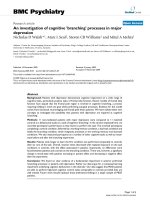
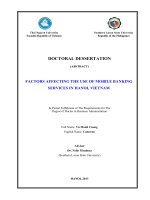
![chung - 2004 - selective mandatory auditor rotation and audit quality - an empirical investigation of auditor designation policy in korea [mar]](https://media.store123doc.com/images/document/2015_01/06/medium_bpj1420548143.jpg)
